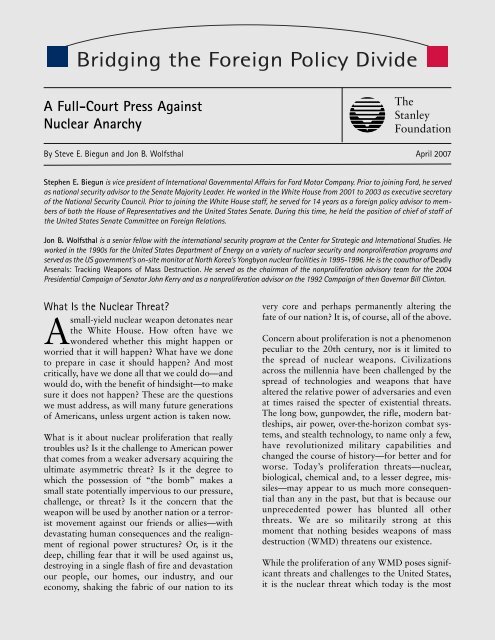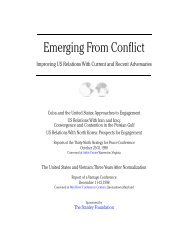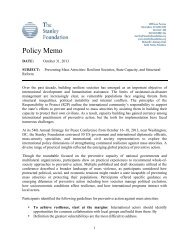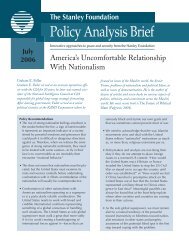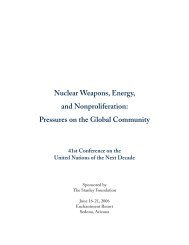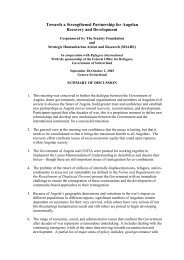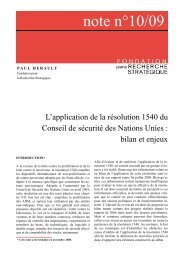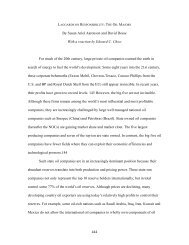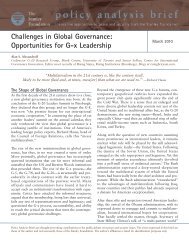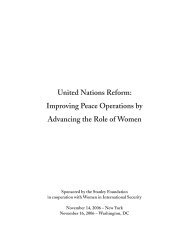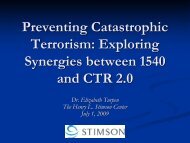A Full-Court Press Against Nuclear Anarchy - The Stanley Foundation
A Full-Court Press Against Nuclear Anarchy - The Stanley Foundation
A Full-Court Press Against Nuclear Anarchy - The Stanley Foundation
You also want an ePaper? Increase the reach of your titles
YUMPU automatically turns print PDFs into web optimized ePapers that Google loves.
Bridging the Foreign Policy DivideA <strong>Full</strong>-<strong>Court</strong> <strong>Press</strong> <strong>Against</strong><strong>Nuclear</strong> <strong>Anarchy</strong><strong>The</strong><strong>Stanley</strong><strong>Foundation</strong>By Steve E. Biegun and Jon B. Wolfsthal April 2007Stephen E. Biegun is vice president of International Governmental Affairs for Ford Motor Company. Prior to joining Ford, he servedas national security advisor to the Senate Majority Leader. He worked in the White House from 2001 to 2003 as executive secretaryof the National Security Council. Prior to joining the White House staff, he served for 14 years as a foreign policy advisor to membersof both the House of Representatives and the United States Senate. During this time, he held the position of chief of staff ofthe United States Senate Committee on Foreign Relations.Jon B. Wolfsthal is a senior fellow with the international security program at the Center for Strategic and International Studies. Heworked in the 1990s for the United States Department of Energy on a variety of nuclear security and nonproliferation programs andserved as the US government’s on-site monitor at North Korea’s Yongbyon nuclear facilities in 1995-1996. He is the coauthor of DeadlyArsenals: Tracking Weapons of Mass Destruction. He served as the chairman of the nonproliferation advisory team for the 2004Presidential Campaign of Senator John Kerry and as a nonproliferation advisor on the 1992 Campaign of then Governor Bill Clinton.What Is the <strong>Nuclear</strong> Threat?Asmall-yield nuclear weapon detonates nearthe White House. How often have wewondered whether this might happen orworried that it will happen? What have we doneto prepare in case it should happen? And mostcritically, have we done all that we could do—andwould do, with the benefit of hindsight—to makesure it does not happen? <strong>The</strong>se are the questionswe must address, as will many future generationsof Americans, unless urgent action is taken now.What is it about nuclear proliferation that reallytroubles us? Is it the challenge to American powerthat comes from a weaker adversary acquiring theultimate asymmetric threat? Is it the degree towhich the possession of “the bomb” makes asmall state potentially impervious to our pressure,challenge, or threat? Is it the concern that theweapon will be used by another nation or a terroristmovement against our friends or allies—withdevastating human consequences and the realignmentof regional power structures? Or, is it thedeep, chilling fear that it will be used against us,destroying in a single flash of fire and devastationour people, our homes, our industry, and oureconomy, shaking the fabric of our nation to itsvery core and perhaps permanently altering thefate of our nation? It is, of course, all of the above.Concern about proliferation is not a phenomenonpeculiar to the 20th century, nor is it limited tothe spread of nuclear weapons. Civilizationsacross the millennia have been challenged by thespread of technologies and weapons that havealtered the relative power of adversaries and evenat times raised the specter of existential threats.<strong>The</strong> long bow, gunpowder, the rifle, modern battleships,air power, over-the-horizon combat systems,and stealth technology, to name only a few,have revolutionized military capabilities andchanged the course of history—for better and forworse. Today’s proliferation threats—nuclear,biological, chemical and, to a lesser degree, missiles—mayappear to us much more consequentialthan any in the past, but that is because ourunprecedented power has blunted all otherthreats. We are so militarily strong at thismoment that nothing besides weapons of massdestruction (WMD) threatens our existence.While the proliferation of any WMD poses significantthreats and challenges to the United States,it is the nuclear threat which today is the most
2grave and one that requires an urgentresponse. Chemical weapons are horrendousin their effect and, if deployed for maximumdamage, can cause severe casualties whetherused by terrorists or on a battlefield. Yet chemicalweapons can also be defended against,remediation is within our capabilities, andultimately their value as a weapon is limited totactical or terrorist purposes.Biological weapons are undoubtedly capable ofcausing far more damage than chemicalweapons. It is even conceivable that the casualtiesfrom a biological weapon attack couldexceed those of a nuclear blast. <strong>The</strong> humantoll, the economic consequences, and the difficultremediation from a biological attack putthese weapons in contention as potentially themost dangerous for the United States. But ultimately,people will be able to recover from anybiological weapons attack. This is not to minimizethe threat of biological weapons or denythe fact that, unlike chemical weapons, they canbe used as a strategic weapon. Nonetheless,with biological weapons there is a prospect ofrecovery and remediation, a hope that after theattack itself has run its course, the consequencescan be limited and, in some cases, even preventedor reversed.<strong>The</strong> comparative permanence of a nuclearweapons attack’s impact makes this, for us,the gravest threat we face as a nation. In a splitsecond, the blast from a nuclear weapon coulddestroy every structure within its range. Everyliving creature within the blast would be incinerated.<strong>The</strong> immediate area of the blast wouldbe so thoroughly irradiated that it would be<strong>The</strong> <strong>Stanley</strong> <strong>Foundation</strong>’s Bridging the ForeignPolicy Divide project brings together pairs offoreign policy and national security specialistsfrom across the political spectrum to find commonground on ten key, controversial areas ofpolicy. <strong>The</strong> views expressed in this paper arenot necessarily those of their organizations orthe <strong>Stanley</strong> <strong>Foundation</strong>. <strong>The</strong> series is coeditedby Derek Chollet, senior fellow at the Centerfor a New American Security; Tod Lindberg,editor of the Hoover Institution’s journalPolicy Review; and <strong>Stanley</strong> <strong>Foundation</strong> programofficer David Shorr.uninhabitable for long periods of time. <strong>The</strong>secondary consequences from radioactive fallout,economic disruption, and perhaps eventhe decapitation of the US government wouldbe incalculable. <strong>The</strong> devastation would carryacross generations and the nation would befundamentally altered.Any assessment of this threat begins with thequestion of identifying the international actorsthat have the wherewithal to acquire a nuclearweapon. Today nine countries are known tohave nuclear weapons: the United States,Russia, the United Kingdom, France, China,Israel, India, Pakistan, and North Korea. Iran isaggressively pursuing a nuclear weapon capability,and others in the Middle East, confrontedby the regional implications of Iran’s nuclearweapons program, are actively considering theirnuclear options. This latter group includesTurkey, Egypt, Saudi Arabia, and other GulfStates. Add to this list the more than 40 statesthat possess either weapon-usable nuclearmaterials, the means to produce such materials,or the technical capability to produce nuclearweapons in weeks, months, or years.In addition to the known and prospectivenuclear powers, there are the nonstate actors.Terrorist movements, especially Al Qaeda,have long expressed a wish to acquire anykind of nuclear device. Rogue and criminalelements within the established nuclear powershave surely contemplated how they wouldacquire and profit from a nuclear weaponstolen from their nation’s arsenal. It is entirelyplausible that as North Korea—and perhapsIran—acquire nuclear weapons, the difficultyof transferring them to terrorist movementswill be eased substantially. And if a terroristmovement were to acquire a nuclear device, itis almost certain that the constraint on its usewill be lowered even more.Ultimately, there are many scenarios for how anuclear weapon could be acquired for useagainst the United States. One possibilitywould be the transfer—intentional or otherwise—ofa nuclear device from Iran, NorthKorea, or Pakistan to a terrorist organization.Also feasible is the theft and transfer of a
weapon from Russia’s nuclear arsenal. A terroristmovement might also acquire materialsto build their own nuclear weapon from anyof the aforementioned countries or some othersource, though this would require additionalequipment and know-how. At the less likelyend of the spectrum would be the theft of aweapon from the other nuclear powers—theUnited States itself, China, France, the UnitedKingdom, or Israel. Finally, the threat of anuclear exchange among the nuclear powersthemselves cannot be dismissed, perhaps precipitatedby some regional conflict or otherunforeseeable sharp rise in tensions. It is ironicthat, given the Cold War preoccupationwith possible war between the major nuclearpowers, this latter scenario seems to be theleast alarming of all the potential threats.Considering which governments have recentlyacquired or are actively seeking a nuclearweapon, and understanding the likelihood thata nuclear-armed terrorist movement might notbe far behind, it is impossible to avoid the sensethat we are losing control of nuclear weaponsproliferation. Priorities for action must be identifiedright away. Policymakers must assesswhere the threats are greatest and where theproliferation chain is most vulnerable, andclarify what steps must be taken immediatelyand what can wait in order to formulate aneffective response. At this juncture, no goodidea should be put aside, and every element ofpolicy must be vigorously reenergized—frommultilateral diplomacy to military preemption.<strong>The</strong> consequences of failure are too catastrophicto approach the issue with anything less thanthe utmost urgency.Why Do States and Terrorist GroupsWant the Bomb?Another key to understanding the proliferationchallenge is to focus on why states seeknuclear weapon capabilities. For the mostpart, states seek to acquire nuclear weaponsfor security purposes. From the ManhattanProject to North Korea’s nuclear efforts (andnumerous cases in between), security motiveshave traditionally been at the core of nucleardevelopment efforts. Some motives have beendefensive, with states seeking to acquirenuclear weapons to deter an attack by anadversary, while others have sought toenhance their security by using nuclearweapons to demonstrate their power andwield influence. While some countries havesought nuclear weapons for their global securityinterests, others have focused on regionalsecurity problems or imbalances.For states outside the international economicor legal mainstream, nuclear weapons acquisitionis sometimes a means of achieving generalpolitical goals, helping to fend off any outsideinterference in their plans. Sometimes the aimof such “rogue states” is to alter the regional orglobal balance of power. Yet even in thesecases, it is ultimately a quest for security (toshield a regime from any countering actions)that underlies the interest in nuclear weapons.<strong>The</strong> acquisition of nuclear weapons by anynew state poses a threat to the security of theUnited States, affecting our ability to protectthe United States, our allies, or our nationalinterests. In some cases, such as North Koreaand Iran, this is a key part of their desire toacquire a nuclear capability: to affect US securitycalculations. While other potential proliferatorsmay not present a direct or asimmediate a challenge to US interests, all suchcases threaten to complicate the internationalorder by directly spurring subsequent proliferation,reinforcing the trend toward a morenuclear world, or increasing the chances of theloss of control over nuclear assets.Security is not the sole driver for proliferation,however. Throughout the nuclear age, differentstates have acted out of a complex set ofmotives as they work to acquire nuclear capabilities.Nationalism and the desire for internationalprestige are growing as motivations forpursuing nuclear technology since, in manyparts of the world, nuclear technology is still apotent symbol of development, advancement,and independence. Moreover, due in part tothe behavior of the established nuclearweapon states, nuclear status continues toconfer prestige on the international stage.Some states seeking international respect haveseen nuclear weapons as an effective means to3
4that end. <strong>The</strong> fact that the five permanentmembers of the United Nations SecurityCouncil all have nuclear weapons is not loston other countries. <strong>The</strong> connection betweennuclear development and modernity is also apowerful symbol that leaders want to showcasefor their own publics, most recently inIran, but previously in India and Pakistan aswell. As long as nuclear weapons and nuclearpower are seen as landmarks of advancement,states will consider them important and worthpursuing. <strong>The</strong> domestic factor in proliferationis often critical, and often more difficult toaddress than straight security calculations.<strong>The</strong> development of nuclear technology has apowerful domestic political effect in somecountries, often after having been stoked byyears of populist rhetoric. This is especiallytrue in India and Pakistan, and apparently inIran. Bureaucratic and institutional pressureswithin a government should not be discountedas a domestic factor in nuclear weapon programs.Once nascent nuclear developmentprograms are initiated, they can be very difficultto restrain and reverse, and bureaucraticforces can be quite effective at exploitingdomestic political or economic considerationsfor their own purposes.In contrast, terrorist groups seek to acquirenuclear weapons for one reason: to use them(probably as quickly as possible). Those seekingsuch capabilities have likely done so with a particulartarget in mind. <strong>The</strong> acquisition and useof a nuclear device by a terrorist group wouldinflict massive damage and instill pervasivepopular anxiety in the targeted country. Thismakes them the ultimate terror weapon. In thewake of a terrorist attack, there would be noway of knowing if the perpetrators had additionalweapons in reserve. An attacker mighttherefore seek to blackmail countries with thethreat of further nuclear attacks. With littlehope of deterring future attacks, it is impossibleto predict how a country’s population or leadershipwould respond to such an ultimatum.Key to any discussion of nuclear terrorism isthe question of whether nuclear armed terroristgroups can be deterred. With all due respectto the academic debate on the issue, the riskthat a subnational group would use a device inits possession is high, and the consequencesare so great that no country or leader couldtake any comfort in the possibility that a terroristorganization might show restraint afterhaving gone to the lengths required to build oracquire a nuclear device.Aside from detonating a weapon to terrorizethe target population and leadership, are thereother motives for terror groups to go nuclear?One could imagine a competitive drive toinflict more damage than the 9/11 attack ormount a challenge to Al Qaeda as the top globalterror group. But these are merely secondarymotives when compared to the desire to inflictultimate terror with the ultimate weapon.While states and substate groups might havedistinct motives for acquiring nuclear weapons,the link between state and substate proliferationis a direct one. Terrorists cannot producetheir own nuclear materials, and thus mustseek to acquire them from the peaceful or militarystocks of state programs. <strong>The</strong>refore, thedistinction often drawn between a nuclear terrorthreat from a state versus nonstate terrorismis false, and the two types of threats shouldalways be considered in connection with oneanother. This is clearly the case in Iran, whereconcerns are high that Tehran might passnuclear capabilities to terrorist groups, but thislink has been often overlooked in other cases ofpotential proliferation.Where Do We Go From Here?For the past 15 years, the debate over howbest to address the proliferation of nuclearweapons and other WMD has been viewed asa choice between response and prevention. Forthe pro-“regime” camp, which emphasized thearms control norms and laws as a bulwarkagainst proliferation dating back to the 1960s,any policy options treating proliferators as anew or emerging reality detracts from the “primary”effort. At the same time, the counterproliferationand preemption camps pushedfor aggressive action to counter the inevitablespread of such weapons, even at the expenseof diplomacy and support of the traditional
6with such a world should it come to pass.While the value and relative importance ofsome of the tactics used to pursue nonproliferationgoals have been in dispute, theunderlying goal is the same: prevent, andwhen prevention is not possible, deter andprepare to defeat as needed.Just as it has in the past, the United Statesmust be at the forefront of internationalefforts to reduce the supply and demand fornuclear weapons through a comprehensiveeffort. If the United States fails to provide suchleadership, then the world is sure to be a moreproliferated one. And even if the best US-ledinternational efforts do falter or fail, then wemust be in a position to protect our vitalnational interests in a more nuclear world.A Turning Point?A remarkable political and policy convergenceoccurred in January 2007 when a bipartisangroup of senior statesmen issued a collectivewarning: “Unless urgent new actions are taken,the United States soon will be compelled toenter a new nuclear era that will be more precarious,psychologically disorienting, and economicallyeven more costly than was Cold Wardeterrence.” 1 <strong>The</strong> combined heft of a group thatincluded George Shultz, William Perry, HenryKissinger, and San Nunn could help open up thepolitical space for a new president to seek a newconsensus in American politics regarding howto address the growing nuclear dangers. Indeed,it was just such a collective realization in the1960s that led the major powers to cooperate inreducing the demand for nuclear weapons andlargely kept their spread in check. A new commitmentto ambitious, international action isabsolutely critical in order to avert the impendingthreat of widespread proliferation.<strong>The</strong> United States’ ability to build global consensuson a new nonproliferation agenda will nodoubt be complicated by the war in Iraq andconcern over the United States’ more active useof the military in the post-9/11 period. For theUnited States to lead a new international efforton the nuclear front successfully, a concertedeffort to restore its international image andinfluence will be essential. This will requireaction on multiple fronts beyond the nuclearagenda itself, including the more effective use ofmultilateral diplomacy and bolstering the UnitedStates’ conventional forces—both to give it bettermilitary options to deal with proliferationand to reduce Washington’s reliance on nuclearweapons as a nonproliferation tool. 2 Despitethese challenges, a US policy of active diplomacy,support for international norms and institutions,and leading by example will attractinternational support and significantly boost thechances of success.In implementing such an agenda, the highest levelsof government must pursue all elements withequal vigor. <strong>The</strong> cooperative measures are just asimportant as the more aggressive counterproliferationsteps: potential deep reductions innuclear weapons, support for a broad set ofnegotiated agreements, engagement with statesfriendly and otherwise to achieve stated goals,and an effort to undercut the basic assumptionsof why states acquire nuclear weapons and thelengths to which the United States should go toprevent their proliferation. In practical terms, thiswill involve exploring anew the means throughwhich agreements are verified; helping to rebuildand reinforce the nonproliferation norms as codifiedin international legal agreements; supportingdeep, verifiable, and irreversible nuclearreductions in the United States, Russia, and othernuclear arsenals; and enlisting broad support toenforce international norms and legal obligations.It will be necessary to reexamine traditionallysacrosanct issues such as the contours of theNon-Proliferation Treaty (NPT) regime, cooperationand engagement with non-NPT members,and a healing of the ideological breachthat has characterized traditional nonproliferationdebates. Neither more of the same normore of the past has any chance of succeeding.At the same time, all sides must recognize thepossibility that trends and developments may1January 7, 2007, <strong>The</strong> Wall Street Journal.2<strong>The</strong> actions needed in a number of other policy areas are covered in other papers of the <strong>Stanley</strong> <strong>Foundation</strong>’s Bridgingthe Foreign Policy Divide project.
have already gone too far to prevent the widerspread of nuclear weapons. Such an ambitiousnew agenda will take time, and the timeline ofnuclear programs in Iran, North Korea, andelsewhere may have lent nuclear proliferationan irreversible momentum. Given the difficultyof nuclear rollback, the United States mustalso prepare itself to operate in a world ofgreater proliferation. This includes maintaininga large and robust conventional militaryforce with improved mobility; global strikeand intelligence capabilities; as well as a safe,reliable, and robust nuclear deterrent.Moreover, in a world where many morecountries have nuclear weapons, there is agreatly increased risk of both nuclear terrorismthrough theft and diversion of nuclearmaterials and of accidental or unintendednuclear use through miscalculation. <strong>The</strong>United States must ensure that it can protectitself, its friends, and its allies as well as itsglobal interest in such a world; this includespursing the most effective defense againstpotential attack, and preparing itself torewrite longstanding legal and politicalnorms to adjust to a more nuclearized world.At some point, such a reassessment will haveto consider a revision of US nonproliferationlaws and restrictions as well as deeperengagement and cooperation with friendlystates that possess nuclear capabilities outsideof the NPT.In their statement, Shultz et al. list key pointsthat should be included in a new initiativewith broad international support. It is worthreviewing this agenda to take stock of theissues and what action will be needed.• Reduce the alert status and deployment ofCold War-era nuclear arsenals (de-alerting).Whatever the threats facing the UnitedStates, they do not require the maintenanceof thousands of nuclear weapons on alert,ready to launch in minutes. <strong>The</strong> UnitedStates should, in conjunction with othernuclear states, reduce the risk of a nuclearaccident by removing a large proportion ofits weapons from their delivery platforms tosecure storage sites, thereby lengthening thenuclear fuse and reducing the number of targetsfor terrorist theft or attack. A majordiplomatic push should be made to convinceRussia, China, and other nuclear powers todo the same.• Make substantial reductions in the nucleararsenals of all states.<strong>The</strong> number of nuclear weapons in theworld remains too high and undercuts thecredibility of commitments by the nuclearpowers to a nuclear-free world. Seeking continued,real, and verifiable reductions inglobal nuclear arsenals should be a centralpillar of international efforts to prevent proliferation,and the United States shouldremove any doubts about its compliancewith its international obligations, includingthe NPT.• Eliminate tactical nuclear weapons designedfor forward deployment.<strong>The</strong> United States has done this with many,but not all of its weapons. Russia hasreversed previous moves to reduce itsreliance on battlefield nuclear weapons.Efforts to secure and eliminate tacticalnuclear weapons dating back to the early1990s should be revived, accompanied by anew multilateral push to verifiably rid theworld of these weapons, which are especiallyprone to theft and terrorist use.• Initiate a new process within the US Senateto boost confidence in and to achieve theratification of the Comprehensive Test BanTreaty (CTBT), as well as push for ratificationby other states.<strong>The</strong> Senate rejection of the CTBT was basedin part on concern over the reliability of theUnited States’ nuclear deterrent under a testban and also regarding the verifiability ofthe agreement itself. An effective, globallegal prohibition against nuclear testingwould help impede the progress of nationsdeveloping nuclear weapons. <strong>The</strong>re shouldbe strong bipartisan support for an agreementthat could be effectively verified. Anew, blank-slate assessment of verificationand modeling technology will be essentialfor the reconsideration of an effective CTBT.7
8• Ensure the highest level of security for allnuclear weapon-usable materials worldwide.<strong>The</strong> vulnerability of nuclear materialsaround the world remains an acute securitythreat and must be the focus of renewedefforts by the US government, the G-8, andall governments that seek an end to proliferationand the threat of nuclear terrorism. <strong>The</strong>political, technical, and economic means toachieve this goal must be marshaled.• Achieve international control of the nuclearfuel cycle through multilateral efforts,including the International Atomic EnergyAgency (IAEA), nuclear suppliers group,and other efforts.This complex issue has been the subject ofserious proposals by the United States,Russia, and the IAEA. Bureaucratic effortsat the working level to develop new ideas areongoing. However, the complexity and costsassociated with such efforts cannot besolved by technical experts and will requiresustained involvement by the top politicallevels. Control over the production ofnuclear fuel is critical to ensure that thespread of technical know-how does notundermine the goals of nonproliferation.<strong>The</strong> authors differ over the future role of theNPT, but agree on the underlying need forinternational political consensus over nonproliferationnorms. <strong>The</strong> NPT played animportant role in stemming the proliferationof nuclear weapons through the Cold Warperiod, although it is difficult to distinguishhow much of that effectiveness was due tothe influence of two superpowers that bothsought to limit the spread of nuclearweapons, rather than the treaty itself.Nonetheless, the Cold War-era experiencedoes point toward the importance of consensusamong the established nuclear weaponsstates as a sine qua non for effective multilateralaction against proliferation. Thus theUnited States should also seek to bringtogether leaders from key states—including,but not restricted to, the P-5 members of theUN Security Council—to forge a new nonproliferationconsensus. <strong>The</strong> 1991 meeting ofthe heads of state of the UN Security Councilthat declared the proliferation of WMD wasa “threat to international peace and security”is an important precedent, but new politicalefforts will require much greaterhigh-level attention as well as a moredetailed set of goals. It would be surprising ifsuch a new consensus did not include a reaffirmationof the NPT itself but, in the end, itis the consensus and the effectiveness of itsresults that are most important and shouldbe the primary focus.• End the production of fissile materials forweapons worldwide and end the use ofweapons-grade uranium in civil applications.<strong>The</strong> United States stopped production of allsuch materials in 1988, and has endorsed anegotiated ban in the Conference onDisarmament. However, the United Stateshas opposed verification measures for suchan agreement, believing it inherently unverifiable.<strong>The</strong> goal of US policy should be toengage in comprehensive negotiations,including consideration of verification, andideological preconditions should not stand inthe way of pursuing the benefits of an agreement.A fissile fuels agreement with adequateverification terms and sufficient scope receiveUS support and Senate consent.• Redouble efforts to resolve regional tensionsthat give rise to new nuclear powers.Festering regional disputes and instabilityfeed the proliferation threat in multipleways. <strong>The</strong>y can spark further demand fornuclear weapons, lay the seeds for regionalnuclear wars, and threaten to drag theUnited States into conflicts and potentialconfrontation with other nuclear powers.Nightmare scenarios are easy to imagine.<strong>The</strong> United States thus must lead in resolvingsuch disputes.• Continue to develop effective measures toimpede or counter nuclear-related conduct thatthreatens the security of any state or peoples.Any comprehensive nonproliferation effortmust include the means to detect and respondto violators, particularly those who illegallytraffic in nuclear technologies. Extendingglobal detection and interdiction efforts and
olstering the United States’ own political andmilitary capacity to counter the spread ofnuclear weapons and technology is fully consistentwith the goals outlined above. Americanpolicymakers should build both unilateralcapacity and international cooperation asurgently and energetically as possible.To be successful, the ambitious agenda outlinedhere will require a tremendous investmentin political and other resources. Ifpursued diligently, this agenda offers hopethat the current trends toward a more nuclearproliferated world can be stopped, and evenreversed. Yet while these steps constitute abold policy agenda, they must be consideredmerely a part of a wider ongoing effort.Traditional tools designed to reduce the availabilityand incentive to acquire nuclearweapons have been a critical part of pastefforts to prevent the spread of nuclearweapons, and will remain a valuable set oftools in the years to come. This intricate andinterlocking set of activities includes:› Export controls to block the transfer of sensitivetechnologies and thereby increase thebarriers facing states in their efforts to developweapons.› Unilateral and multilateral economic anddiplomatic sanctions against states seekingor trading in illicit technologies.› Homeland security and national defense programs,including detection and interdiction.› Development of missile defense technology toreduce the odds that a would-be attackercould succeed in striking the United States.<strong>The</strong>se efforts, taken together, form the backboneof current nonproliferation efforts and must becontinued and continually reinvigorated.<strong>Nuclear</strong> Weapons and US PolicyIn pursuing such a multifaceted agenda, theUnited States must also engage in a long-neededpublic discussion about what role nuclearweapons do, should, and will play in US policy.Fundamental questions should be raised anddebated, including why we have nuclearweapons; how many we need; what role canthey play, if any, outside of the nuclear deterrentcalculation; and whether and how theUnited States can work toward completenuclear disarmament. <strong>The</strong> continued directionof US nuclear policy must not be driven by themere inertia of the Cold War momentum.General James Cartwright, commander ofStrategic Command, has endorsed the need fora new national dialogue on the role of nuclearweapons in US policy: “<strong>The</strong> challenging securityand threat environment of the 21st centurysignals the need for an informed nationallevel discussion to hear the voices of governmentleaders, military, academia, and the publicif we are to effectively establish a long-termnuclear investment plan.” 3<strong>The</strong>re are serious decisions to be made in thisprocess. Key among them will include theUnited States’ strategy for maintaining its currentnuclear arsenal, possible efforts to developnew weapons, how to ensure reliable androbust delivery capabilities as long as theUnited States retains a nuclear arsenal, andhow to balance US nonproliferation andnuclear deterrent requirements.If the spread of nuclear weapons is indeed theprincipal threat of our time, then every meansat the government’s disposal must be focusedand integrated to prevent these threats fromharming US security. <strong>The</strong>refore, US nuclearweapon and conventional military capabilitiesmust be configured and geared toward supportingoverarching US efforts to prevent thespread of nuclear weapons. For some, thisargues for the development of new, smaller,battlefield nuclear weapons to put adversaries’underground targets at risk, while othersinvoke nonproliferation objectives to advocatea ban on nuclear testing, a reduction in thenumber of nuclear weapons, and a declarationthat US nuclear weapons will only be used fornuclear deterrence.For a new international nonproliferation consensusto have any chance of success, theUnited States must throw its full political93April 4, 2005, testimony before the Senate Armed Services Committee.
10weight behind such an effort. This will requirea delicate balance between political and militaryaims. For instance, the first priority in anyeffort to develop a reliable replacement warheadmust be to develop technologies toensure reliability while avoiding the need totest nuclear weapons. <strong>The</strong> current efforts withinthe nuclear establishment have been prudentand sound—aiming to design a reliablereplacement warhead without testing thatcould be put into service if weapons in theexisting US nuclear stockpile were to provedefective. Ultimately, if pursued within thecontext of a broader, more robust nonproliferationagenda, this capability would also buildthe basis for reconsideration of the CTBT.Also, the United States, together with the othernuclear powers, should provide assurancesthat nonnuclear states will not be the subjectof nuclear threats. <strong>The</strong> proposed developmentof new nuclear weapons by the United Statesfor possible use in essentially a conventionalcapacity—to reach deep underground targets—isbased on a premise that does not seemcredible. <strong>The</strong> United States could not developand deploy, much less use, such weapons withoutshredding any global consensus thatremains regarding the taboo on the use ofnuclear weapons. Any US use of a nuclearweapon of any type against a nonnuclear statewould cross a line that simply would not beunderstood or accepted by the rest of theworld. <strong>The</strong>re is no meaningful distinctionbetween a large and a small nuclear weaponwhen used against a nonnuclear state.Brave New WorldFor more than 50 years, the United Statesrelied upon a robust nuclear arsenal as a deterrentto any party that may attack our nationwith a nuclear weapon. As successful as thatstrategy has been, the world in which it workedis largely gone. <strong>The</strong> threat of state-to-statenuclear conflict involving the United Statesnow rates among the least likely of contingencieswe may face. As the challenge of nuclearproliferation has evolved, so must our strategy.None of the many types of action suggested inthis paper to meet the challenge of nuclearproliferation are new. To some degree, manyof them are either current policy or have beenin recent administrations. <strong>The</strong> real evolutionneeded in the United States’ strategy is in thearchitecture of the solutions. <strong>The</strong> policy mustinclude both multilateral diplomacy androbust unilateral action. It must balance cooperativeinitiatives on arms control and themaintenance of a safe and effective US nucleararsenal. It must involve diplomacy and thewillingness to use force. In short, it will containcombinations that appear inherently contradictory.It must be a total effort.This task will require a genuine commitmentat the highest levels of government to build aunited international front. Allies must berecruited, including among the new nuclearpowers such as India and even Pakistan. Withthe broadest possible international support,the United States and its partners must launcha layered approach to meet the challenge ofnuclear proliferation.<strong>The</strong> full set of international regimes and norms,of treaties and laws should be invigorated andfurther refined to close off any trade in nuclearweapons technologies with states that do notabide by the NPT—whether they are a party ornot. A comprehensive, global effort must belaunched to catalog, secure and, where possible,recover and destroy nuclear materials. <strong>The</strong>existing nuclear powers should cooperate inreducing their own nuclear arsenals in concert—downto the minimum level necessary fora deterrent against each other. <strong>The</strong> remainingwarheads should then be stored in the mostsecure manner possible. Every effort must bemade to disrupt and interdict the trade ofnuclear materials, especially fissile material.Stopping nations and individuals who participatein this illicit trade should be a priority forintelligence services and the military.Underneath the ambitious strategy laid out bySchulz et al., the United States will need to maintainsafe, reliable, and robust nuclear forces—inthe most strategically stabilizing manner possible—toremain capable of deterring the use ofnuclear weapons by other states against theUnited States and its friends and interests abroad.
Finally, in order to lessen the need for nuclearweapons as well as respond more effectivelyagainst any incipient nuclear threat, theUnited States must maintain large and wellequippedconventional military forces todefeat any potential adversary. <strong>The</strong> UnitedStates must also, as aggressively as possible,locate and defeat terror plots, disrupt terroristnetworks, deny substate groups’ safe havens,and preempt such groups anywhere in theworld. Beyond the detailed policy agenda outlinedhere, protecting the United States fromall serious threats will remain the primaryconstitutional duty for any president.In the end, we may not succeed. At the currentpace of proliferation, it seems likely that newnuclear powers will yet emerge in this decade.With the large number of nuclear weapons invarious arsenals around the world—underwhat may be described as, at best, suspectsecurity—the theft of a device at some point isa distinct possibility. With the growth of terroristorganizations of global reach, the deliveryof a nuclear weapon to America’s shores isby no means far-fetched. <strong>The</strong> explosion ofsuch a device on US territory would then beonly a matter of time. If we are to succeed inmeeting the challenge of proliferation, wemust act—now—as if our lives depend uponit. Someday, they actually might.11<strong>The</strong> Case of IranIran is the single most pressing case confrontingUS nuclear nonproliferation strategytoday. Unlike North Korea, Iran does not currentlypossess a workable nuclear device andmay be several years away from producingone. Thus it is still possible to envision an outcomewhere Iran remains a nonnuclear power,either as a result of diplomacy or due to a combinationof cooperative and coercive means.Iran’s pursuit of nuclear capabilities is of seriousconcern in and of itself, but especiallybecause of its ties to and support of extremistterrorist organizations. <strong>The</strong>re is a very plausiblethreat that Iran might transfer nuclear capabilitiesto nonstate actors who are far more difficultto deter or contain than Iran itself. Iran’spursuit of a weapon will also have a directimpact on regional neighbors, forcing them toconsider developing their own nuclear weaponsas a countermeasure or to take preemptive militaryaction to prevent Iran from going nuclear.<strong>The</strong>re is yet another danger that Iran’s openhostility toward the United States and Israelcould lead them to launch an unprovokednuclear attack.Even if the United States were to develop newrobust nonproliferation measures, there is notsufficient time for such instruments to make amajor contribution toward ending Iran’snuclear ambitions. Thus this challenge must beaddressed with the tools already at the disposalof policymakers. <strong>The</strong> diplomatic partnershipof the United States with key European powersis a critical initiative, and the maximum use ofmultilateral institutions such as the IAEA andthe UN Security Council will remain importantinstruments in seeking to convince Iran tochange its nuclear direction. Iran has consistentlydeflected such efforts and it is conceivablethat nations with competing interests canblock action—particularly in the UN SecurityCouncil. Moreover, Iran’s leadership is clearlyworking to exploit the frustration or suspicionin the Middle East and elsewhere in the developingworld toward US policy of the pastdecade. <strong>The</strong> United States must therefore pursuea full-court diplomatic press using all availableand conceivable tools to reinforce itsnonproliferation goals in Iran.<strong>The</strong> first level of action is political and economicpressure, including the most restrictive sanctionspossible if Iran refuses to halt its nuclearenrichment program in particular, and its pursuitof a nuclear weapon more generally. <strong>The</strong>position of Iran’s leadership is not as strong economicallyor politically as it might appear atfirst glance. <strong>The</strong> internal political and economicimpact of sanctions may have a greater impactthan many expect. This pressure can then beused to create a greater incentive for Iran’s leadersto compromise on key issues. To this end,direct, bilateral diplomacy between the United
12States and Iran should be pursued if there is anyreasonable prospect of halting Iran’s nuclearweapons program. Notwithstanding the otherbroader and serious concerns regarding theIranian regime, preventing the acquisition ofnuclear weapons by Iran must remain a toppolicy goal. Other objectives—including regimechange—should be secondary as long as achance remains to end Tehran’s nuclear ambitionsthrough peaceful means. This does notmean that the United States should discontinueits efforts to detect and deter Iranian supportfor terrorism and to push Iran to permit its peopleto enjoy the full liberties of a free society—including the right to choose their leaders. Itmeans only that ending Iran’s nuclear weaponsprogram should be the highest priority.Given the existing US military commitments inIraq, Afghanistan, and elsewhere, Iran andother countries in the Middle East believe theUnited States is either incapable of or unlikelyto consider military actions against Iran. Mostregional players oppose the use of militaryforce to stop Iran’s nuclear program. Yet stoppingthe development of an Iranian nuclearweapon remains a US national security imperativeof such enormity that the use of militaryforce must remain a real option for Americandecision makers. <strong>The</strong> United States shouldcontinue planning for such an operation andpreparing for the potential consequences ofsuch an action—especially the likely increasein terrorist attacks worldwide and the potentialdisruption of energy supply lines from theregion. Such contingency preparation, pursuedwithin reason, would increase the senseof vulnerability in Iran and could make itmore willing to seek a compromise on thenuclear issue.While the United States does not currentlyhave sufficient military resources to invade andoccupy the nation of Iran, it does have the abilityto use force to disrupt those nuclear capabilitiesthat it can identify. While even this, inthe end, may not prevent Iran from goingnuclear, it must remain a possible option if forno other reason than to reassure US allies inthe region that Washington is committed totheir defense and protection as well as to maintainingpressure on Iranian decision making onnuclear and other issues.<strong>The</strong> crisis over Iran’s nuclear ambitions is likelyto continue for many more months. Developingand implementing a comprehensive new nonproliferationagenda will take much longer. Butcommencing the work toward such an agendacould have immediate benefits for the effort toslow or end Iran’s nuclear efforts. Demonstratingin an international context that the United Statesand the world’s major powers understand andrecognize the risk of unchecked nuclear proliferationand the responsibility to include themselveswithin a new broader system of controls mayprove critical in the intensifying diplomacy surroundingIran’s nuclear program. Coming on theheels of renewed efforts to develop diplomaticsolutions to the North Korean nuclear crisis, anyprogress on the Iran front—even a suspension ofIran’s enrichment program and the start of a realdialogue between Iran and the outside world onsecurity issues—could go a long way in layingthe foundation and building global politicalmomentum for the new nonproliferation agendalaid out in this paper.<strong>The</strong> <strong>Stanley</strong> <strong>Foundation</strong><strong>The</strong> <strong>Stanley</strong> <strong>Foundation</strong> seeks a secure peace with freedom and justice, built on world citizenship and effectiveglobal governance. It brings fresh voices, original ideas, and lasting solutions to debates on global and regionalproblems. <strong>The</strong> foundation is a nonpartisan, private operating foundation, located in Muscatine, Iowa, thatfocuses on peace and security issues and advocates principled multilateralism. <strong>The</strong> foundation frequently collaborateswith other organizations. It does not make grants. Online at www.stanleyfoundation.org.Production: Amy Bakke and Margo Schneider209 Iowa Avenue · Muscatine, IA 52761 USA563-264-1500 · 563-264-0864 fax · info@stanleyfoundation.orgPrinted onrecycled paper4/07 1.8K


